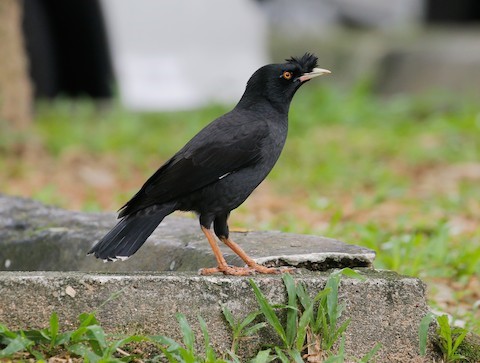Birdfinding.info ⇒ In its natural range, the Crested Myna is generally common across most of eastern China, including the urban areas of Beijing, Shanghai, Hong Kong, and Taipei, among others. Elsewhere, introduced populations are readily found in the vicinities of: Yokohama, Japan; Manila, Philippines; Penang, Malaysia; Lisbon, Portugal; and Mar del Plata, Argentina.
Crested Myna
Acridotheres cristatellus
Native to temperate and subtropical East Asia; widely introduced elsewhere. Mainly in humid open and semiopen habitats, including cities and agricultural fields.
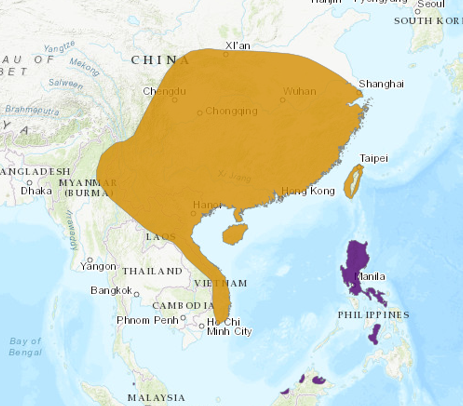
Approximate natural range of the Crested Myna (shown in orange). © BirdLife International 2016
Natural range consists mainly of central and eastern China and adjacent countries: west to Shaanxi, Sichuan, and northeastern Myanmar, north to Hebei and Liaoning, and south to Laos and central Vietnam. Also native to Hainan and Taiwan.
Introduced populations are well-established in several areas. In Asia, there are localized populations: on Honshu (mainly around Osaka and Yokohama); in the Philippines, throughout Luzon and more locally southward on Negros and Mindanao; in Borneo’s north-coastal lowlands from Brunei through Sabah, and in southern Sarawak; and locally across much of peninsular Malaysia.
In Europe, it is well-established around Lisbon, Portugal, and apparently expanding north to Porto, and possibly also east into Spain.
In South America, it appears to be well-established along the Argentine coast in the vicinity of Mar del Plata and Mar Chiquita, with small numbers occurring from Buenos Aires to Neochea, and in the interior around Córdoba. Scattered records indicate an ongoing expansion across much of central Argentina (as far as Chubut, Neuquén, Mendoza, Santa Fé, and Entre Ríos) and likely to Uruguay.
Throughout the 1900s (from the 1890s to the early 2000s), a well-known population existed in the vicinity of Vancouver, British Columbia, with a smaller outpost in Nanaimo on Vancouver Island.
Identification
A medium-large, black myna with a bushy frontal crest, and white wing-patches across the bases of the primaries. Sometimes appears all-black when wings are folded.
The bill is pale greenish-yellow, the eyes are yellowish-orange, and the legs are orange.
The undertail is mostly black with white tips on the coverts and the tail feathers. Viewed from above, the tail is black—usually with very narrow white tips, although these are not always visible.
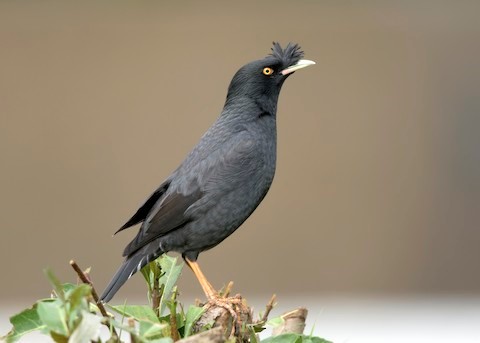
Crested Myna. (Huajiang Wild Duck Nature Park, Taipei, Taiwan; December 12, 2015.) © Arnaud Lacroix
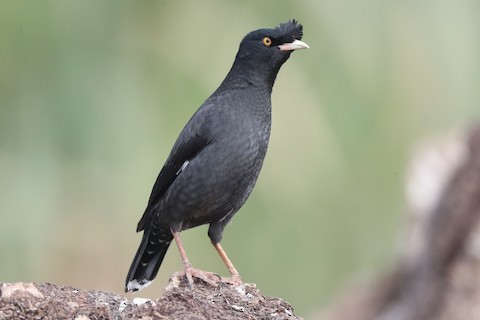
Crested Myna, showing white tips on undertail coverts and tail feathers. (Jinning Huwei River Estuary, Kinmen County, Taiwan; November 30, 2019.) © Ting-Wei Hung

Crested Myna. (Poyang Lake National Wetland Park, Jiangxi, China; February 20, 2014.) © Shelley Rutkin
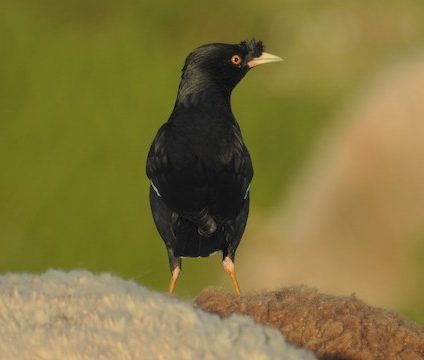
Crested Myna, dorsal view showing almost all-black plumage, with thin traces of white on the folded wings and tail-tip. (Alpena, Arriba Fóssil da Costa da Caparica, Almada, Setúbal, Portugal; March 11, 2016.) © Daniel Raposo

Crested Myna, with white wing-patches concealed—but note the slivers of white barely visible at the tips of the tail feathers. (Penang Botanical Gardens, Pulau Pinang, Malaysia; January 14, 2019.) © Neoh Hor Kee
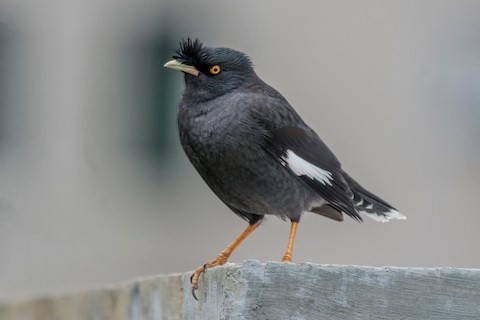
Crested Myna, showing white wing-patches and white tips on undertail coverts and tail feathers. (Shek Kong Airfield Road, Hong Kong; December 29, 2018.) © John Clough

Crested Myna, showing white tips on undertail coverts and tail feathers. (Georgetown, Penang, Pulau Pinang, Malaysia; February 12, 2018.) © Neoh Hor Kee

Crested Myna, showing white tips on tail feathers. (Hsinchu County, Taiwan; April 23, 2016.) © 盈昌 劉

Crested Myna, dorsal view showing almost all-black plumage. (Taipei, Taiwan; March 21, 2020.) © Ann Huang
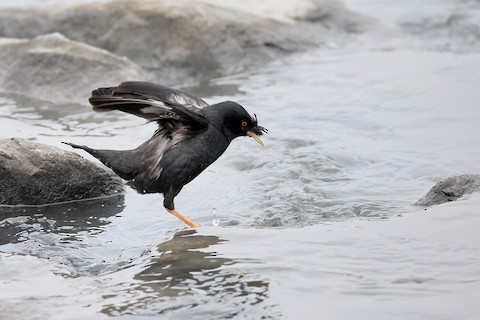
Crested Myna, with wings raised, showing pale areas on sides and flanks. (Wujiang River Estuary, Kinmen County, Taiwan; March 9, 2017.) © Ting-Wei Hung
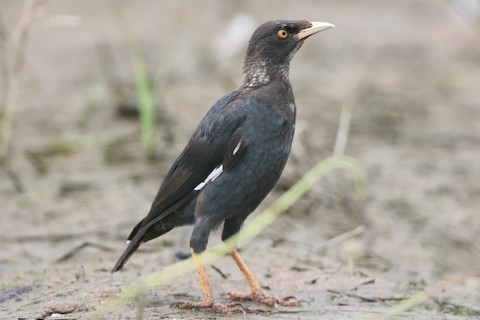
Crested Myna, immature, moulting into adult plumage, with head still brown. (Shagang Ranch, Kinmen County, Taiwan; September 12, 2018.) © Ting-Wei Hung
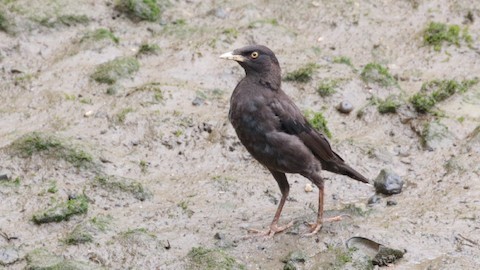
Crested Myna, immature. (Complexo Desportivo Nacional do Jamor, Oeiras, Lisbon, Portugal; August 17, 2016.) © Vasco Valadares
Immatures generally resemble adults but are browner, especially on the head.

Crested Myna, immature, moulting into adult plumage, with head still brown. (Lanyang River Estuary, Yilan County, Taiwan; September 21, 2016.) © JingZu Tu
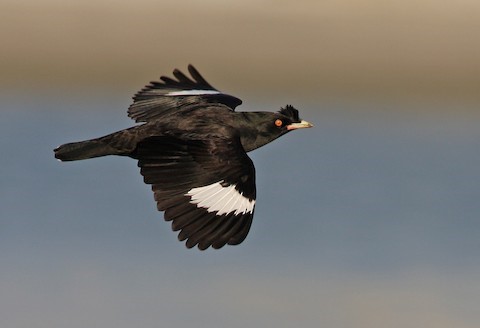
Crested Myna, in flight, dorsal view showing size and position of white wing-patches. (Gelugor, Pulau Pinang, Malaysia; January 15, 2010.) © Dave Bakewell

Crested Myna, in flight, dorsal view of an individual in fresh plumage showing maximum extent of white tips on tail feathers. (Yangguang Sports Park, New Taipei City, Taiwan; February 8, 2018.) © Jerry Ting

Crested Myna, in flight, ventral view showing size and position of white wing-patches. (Shek Kong Airfield Road, Hong Kong; August 10, 2015.) © John Clough

Crested Myna, in flight, ventral view showing minimal white fringes on the tips of the undertail coverts and tail feathers. (Xucuogang, Taoyuan City, Taiwan; January 23, 2019.) © You-Sheng Lin
Cf. Other Acridotheres Mynas. Crested is one of six Acridotheres mynas that share the same basic features: gray-to-black overall with white wing-patches and bushy frontal crests. Four of these are common and widespread and have partially overlapping ranges, due largely to introductions: Great (grandis); Crested (cristatellus); Javan (javanicus); and Jungle (fuscus). The other two are more localized and have more distinctive coloration, as their names suggest: Pale-bellied (cinereus) is endemic to Sulawesi; and Collared (albocinctus) occurs mainly in northern Myanmar.
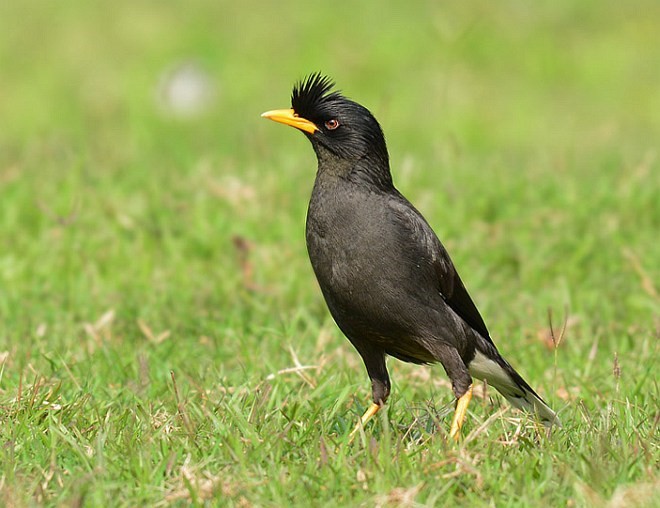
Great Myna. (Tinsukia, Assam, India; March 6, 2016.) © Mayuresh Khatavkar

Crested Myna. (Penang Botanical Gardens, Pulau Pinang, Malaysia; January 14, 2019.) © Neoh Hor Kee
Among the four widespread bushy-crested mynas, Crested is distinctive in three ways: (1) it has the least white on the tail and vent, limited to the tips of the undertail coverts and tail feathers; (2) its bill is greenish-yellow and does not match its leg color; and (3) its eyes are yellowish-orange. It can often be distinguished by overall coloration and crest shape, but these are less reliable.
Tail and Vent Color: Crested’s undertail coverts and tail feathers are narrowly tipped with white, whereas the other species have mostly white undertail coverts and extensively white tail feathers. Seen from above, Crested’s tail is almost entirely black, whereas the others all have a distinct white terminal band and white outer edges.
Bill and Leg Color: Great, Javan, and Jungle Mynas all have matching, or nearly matching, yellowish-orange bills and legs—although Jungle differs in that its bill is strongly bicolored, with a black base. Crested’s bill is pale greenish-yellow (or ivory or “horn-colored”) and its legs are orange, sometimes bright and sometimes dark. The colors of both its bill and its legs differ from those of the others, and they differ from one another.
Eye Color: Although eye color is somewhat variable and less reliable than the other features, it can be helpful for confirmation. Crested’s is roughly intermediate between Great and the other two. Great’s eyes usually appear dark-brown, or reddish when illuminated. Javan and Jungle usually show pale-yellow or whitish eyes, sometimes bluish-white. Crested’s eyes are consistently medium-orange, paler than Great’s and darker than Javan and Jungle’s.
Overall Coloration: The base color of the body plumage differs somewhat, but also varies within species. Typically: Great is close to jet-black; Crested tends to show some gray tones; Javan is dark slaty-gray with a blacker hood; and Jungle is medium slaty-gray with some brown tones and a much blacker hood.
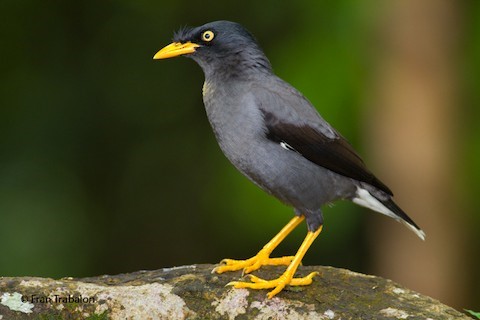
Javan Myna. (Bukit Timah, Singapore; November 15, 2011.) © Fran Trabalon
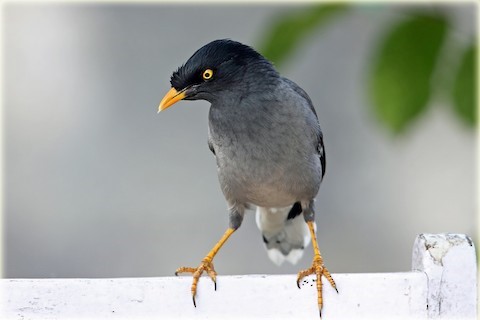
Jungle Myna. (Kathmandu, Nepal; October 7, 2014.) © John Thompson
Crest Shape: Crest shape may be helpful in some cases, but it is often ambiguous because all four species can have short crests. Typically, Great’s crest is longer and spikier than any of the others, and Crested has the next-longest crest feathers. Javan and Jungle’s crest-feathers are always shorter than typical Great and Crested.
Notes
Polytypic species consisting of three recognized subspecies.
References
BirdLife International. 2016. Acridotheres cristatellus. The IUCN Red List of Threatened Species 2016: e.T22710946A94269013. https://dx.doi.org/10.2305/IUCN.UK.2016-3.RLTS.T22710946A94269013.en. (Accessed April 29, 2020.)
Brazil, M. 2009. Birds of East Asia. Princeton University Press, Princeton, N.J.
Craig, A., and C. Feare. 2020. Crested Myna (Acridotheres cristatellus). In Handbook of the Birds of the World Alive (J. del Hoyo, A. Elliott, J. Sargatal, D.A. Christie, and E. de Juana, eds.). Lynx Edicions, Barcelona. https://www.hbw.com/node/60868. (Accessed April 29, 2020.)
eBird. 2020. eBird: An online database of bird distribution and abundance. Cornell Lab of Ornithology, Ithaca, N.Y. http://www.ebird.org. (Accessed April 29, 2020.)
EcoRegistros. 2020. Registros Ecológicos de la Comunidad. Cotorra. http://www.ecoregistros.org/folha/Acridotheres-cristatellus. (Accessed April 29, 2020.)
Feare, C., A. Craig, B. Croucher, C. Shields, and K. Komolphalin. 1999. Starlings and Mynas. Princeton University Press, Princeton, N.J.
Xeno-Canto. 2020. Crested Myna – Acridotheres cristatellus. https://www.xeno-canto.org/species/Acridotheres-cristatellus. (Accessed April 29, 2020.)
